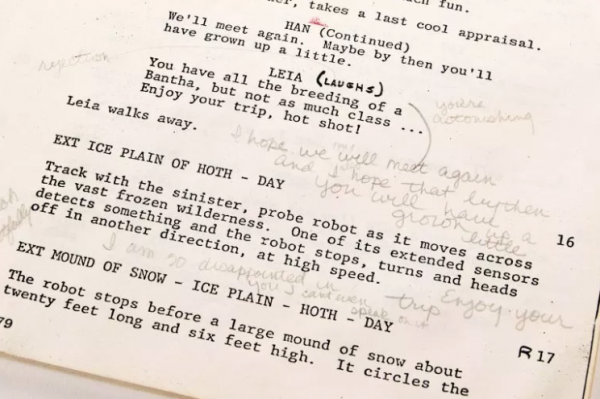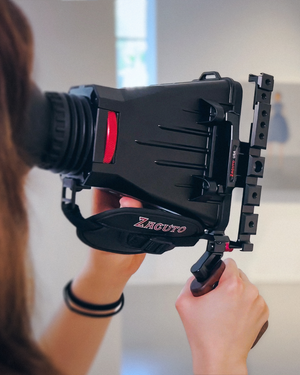
Writing Your Second Draft - How to Revise Like a Pro
Your screenplay's first draft is finished! Congratulations! Maybe a few screenwriter friends have read it and have given you some script feedback, or maybe you've hired a script coverage service to give you some notes, and you're ready to sit down write your second draft.
All good!
But wait.
Before you actually sit down to bang out your screenplay's second draft, and especially before you blast it out into the world at large for producers and agents to read, I'd like to share with you a few tips on making your second draft as tight as possible — things I've gleaned over my two decades of running a script coverage company.
See, my company's sole mission is to provide critical notes to screenwriters. So, as you can imagine, my team and I have seen countless first drafts, and we've seen countless second drafts. But what we've also seen is a handful of mistakes nearly all screenwriters make between draft one and draft two, no matter whether they're amateur writers or seasoned vets.
 For example, we'll tell a writer that it's imperative that they delete such-and-such character, or merge the character with another one, because that particular character is either redundant or is someone we confuse with someone else, or simply because that character slows things down, or dilutes the story's drama, or comedy, or conflict in some way.
After sending that note to the writer, the writer will go away for a while, then come back a few weeks later, sending the second draft for more notes.
We'll read the draft and see that the writer has perhaps addressed a lot of other notes we've given them, but the script is still suffering greatly because the character we told them was imperative to delete is still in there, unfixed, unedited, untouched, still larding up the story.
When writers ignore a major note we give them, that's fine. Script feedback can be a very subjective endeavor, and not everybody has to agree with how best to improve a screenplay.
But if the reason you're ignoring a script note or suggested fix is that you think the note is invalid, because whatever element the note is addressing is something you feel is working fine, I ask that you take an extra minute or two to think about it.
Get into the head of the person offering the note. Make sure it's not just a disagreement because the note-giver "likes vanilla" and you, the writer, "likes chocolate." Sometimes notes require a second look, and a bit of time spent with them. Don't gloss over a suggestion quickly. Only dismiss a suggested fix after you've spent a bit of time considering it. Sometimes, it's not immediately clear from the critical note how much of an improvement the suggested fix would be.
For example, we'll tell a writer that it's imperative that they delete such-and-such character, or merge the character with another one, because that particular character is either redundant or is someone we confuse with someone else, or simply because that character slows things down, or dilutes the story's drama, or comedy, or conflict in some way.
After sending that note to the writer, the writer will go away for a while, then come back a few weeks later, sending the second draft for more notes.
We'll read the draft and see that the writer has perhaps addressed a lot of other notes we've given them, but the script is still suffering greatly because the character we told them was imperative to delete is still in there, unfixed, unedited, untouched, still larding up the story.
When writers ignore a major note we give them, that's fine. Script feedback can be a very subjective endeavor, and not everybody has to agree with how best to improve a screenplay.
But if the reason you're ignoring a script note or suggested fix is that you think the note is invalid, because whatever element the note is addressing is something you feel is working fine, I ask that you take an extra minute or two to think about it.
Get into the head of the person offering the note. Make sure it's not just a disagreement because the note-giver "likes vanilla" and you, the writer, "likes chocolate." Sometimes notes require a second look, and a bit of time spent with them. Don't gloss over a suggestion quickly. Only dismiss a suggested fix after you've spent a bit of time considering it. Sometimes, it's not immediately clear from the critical note how much of an improvement the suggested fix would be.
 So if you want to have a good second-draft experience — or even third-, fourth-, or twentieth-draft experience — learn how to parse feedback, how to contrast it with your own thoughts and brainstorms, be open to coming up with solutions that address problems you know the first draft suffers from.
But most importantly, be ready to listen —to your feedback, your first audience — to your own words on the page because you're frosty and not getting glazed over by becoming overly familiar with your own text.
And no worries! Know your second draft still won't be perfect, or anywhere near, so don't pull your hair out trying to get it there. (That's what 10th drafts are for!) Take as many positive steps forward as you can, and keep those typing fingers nimble and your note-taking pen full of ink, because you've still got a long way to go.
So if you want to have a good second-draft experience — or even third-, fourth-, or twentieth-draft experience — learn how to parse feedback, how to contrast it with your own thoughts and brainstorms, be open to coming up with solutions that address problems you know the first draft suffers from.
But most importantly, be ready to listen —to your feedback, your first audience — to your own words on the page because you're frosty and not getting glazed over by becoming overly familiar with your own text.
And no worries! Know your second draft still won't be perfect, or anywhere near, so don't pull your hair out trying to get it there. (That's what 10th drafts are for!) Take as many positive steps forward as you can, and keep those typing fingers nimble and your note-taking pen full of ink, because you've still got a long way to go.

First draft = listen to your heart. Second draft = listen to your feedback.
The most common mistake we see is writers ignoring the critical notes they've received, or generally glossing over the major, harder suggestions we make and focusing their second-draft revisions on tiny beats or elements, or stuff that wasn't bad to begin with, or, worse, cosmetic fixes, such as formatting and spelling. (Yes, both are important, but really should only be minor concerns at this early point in the script's development, especially relative to more important issues!) For example, we'll tell a writer that it's imperative that they delete such-and-such character, or merge the character with another one, because that particular character is either redundant or is someone we confuse with someone else, or simply because that character slows things down, or dilutes the story's drama, or comedy, or conflict in some way.
After sending that note to the writer, the writer will go away for a while, then come back a few weeks later, sending the second draft for more notes.
We'll read the draft and see that the writer has perhaps addressed a lot of other notes we've given them, but the script is still suffering greatly because the character we told them was imperative to delete is still in there, unfixed, unedited, untouched, still larding up the story.
When writers ignore a major note we give them, that's fine. Script feedback can be a very subjective endeavor, and not everybody has to agree with how best to improve a screenplay.
But if the reason you're ignoring a script note or suggested fix is that you think the note is invalid, because whatever element the note is addressing is something you feel is working fine, I ask that you take an extra minute or two to think about it.
Get into the head of the person offering the note. Make sure it's not just a disagreement because the note-giver "likes vanilla" and you, the writer, "likes chocolate." Sometimes notes require a second look, and a bit of time spent with them. Don't gloss over a suggestion quickly. Only dismiss a suggested fix after you've spent a bit of time considering it. Sometimes, it's not immediately clear from the critical note how much of an improvement the suggested fix would be.
For example, we'll tell a writer that it's imperative that they delete such-and-such character, or merge the character with another one, because that particular character is either redundant or is someone we confuse with someone else, or simply because that character slows things down, or dilutes the story's drama, or comedy, or conflict in some way.
After sending that note to the writer, the writer will go away for a while, then come back a few weeks later, sending the second draft for more notes.
We'll read the draft and see that the writer has perhaps addressed a lot of other notes we've given them, but the script is still suffering greatly because the character we told them was imperative to delete is still in there, unfixed, unedited, untouched, still larding up the story.
When writers ignore a major note we give them, that's fine. Script feedback can be a very subjective endeavor, and not everybody has to agree with how best to improve a screenplay.
But if the reason you're ignoring a script note or suggested fix is that you think the note is invalid, because whatever element the note is addressing is something you feel is working fine, I ask that you take an extra minute or two to think about it.
Get into the head of the person offering the note. Make sure it's not just a disagreement because the note-giver "likes vanilla" and you, the writer, "likes chocolate." Sometimes notes require a second look, and a bit of time spent with them. Don't gloss over a suggestion quickly. Only dismiss a suggested fix after you've spent a bit of time considering it. Sometimes, it's not immediately clear from the critical note how much of an improvement the suggested fix would be.
Don't Glaze Over
Tying in more specifically to the idea of not dismissing notes right away is the need for writers receiving notes to avoid, at all costs, glazing over. By "glazing over," I mean two things, basically. 1) Becoming so familiar with the text on your script's page, especially after years of working on it, that you fail to see details about it, or forget what it's like for a person reading it for the first time. 2) Glazing over someone's critical feedback on your script for any reason, whether that reason is you're eager to get back to writing, or you're just lazy, or you're subconsciously averse to receiving critical feedback. It's vital when writing your second draft that you stay fresh. That is, that you make sure that every word on the page, when you imagine viewing it as a first-time reader, makes sense, communicates what you want to communicate, and, perhaps most importantly, keeps that reader interested in turning the page to see what happens. All too often, we see writers becoming so jaded to their own work that they forget entire scenes in their scripts even exist. Or character names suddenly change on p. 50, or a character who we didn't meet, ever, is now suddenly doing something important and it's clear that that's the result of the writer not thoroughly excising him from the first draft. Stay frosty!Don't Chase Notes, but Follow the Patterns
Between draft one and draft two, you'll likely get a lot of feedback. While you don't want to be a people-pleaser and address every single note no matter how big or small, at the same time, you need to be able to spot patterns in the feedback you're receiving. For example, if your friend Maria reads your script and tells you the farmhouse exploding on p12 is a bit much, consider her note, sure, but know it's just one person's opinion. If your manager Sally reads your script and tells you the same thing Maria told you, about the farmhouse exploding, then maybe you should dig into that scene a little more closely and see if you can improve it. But if ten people all read your script and all ten, or a big chunk of that ten, tell you the farmhouse scene has to go, then the farmhouse scene probably has to go, or be completely rewritten from scratch. Don't be precious about your writing. You're writing for an audience. These people are your first audience. Look for patterns in the feedback they give you. A one-off note is one thing, but if you spot a recurring theme or criticism, you need to pay attention.Know There are Many, Many More Drafts to Go
Finally, know that your second draft probably won't (and probably shouldn't) be the draft you first send out into the world, to agents, managers, and producers. The span in the timeline between first draft and script-ready-for-human-consumption is often a very long one. The script is going to get better with each and every revision, with each and every note, and with each and every brainstorm you have. That process takes time. Know before sitting down to write your second draft that characters you're writing now, situations, scenes, plot points — all of these things might actually be gone two drafts from now, or ten drafts from now, obliterated entirely or replaced by better stuff. That's because a first draft is supposed to be where all the writer's inspiration and passion comes out for the first time, in one big, sloppy burst. A writer is in the "sandbox," so to speak, so she can feel free to write for herself, with as creative recklessness as she likes. Because she's just getting her story down onto her page. But the second draft is when a writer really needs to take that first serious step towards writing for the audience as well, and not just herself. So if you want to have a good second-draft experience — or even third-, fourth-, or twentieth-draft experience — learn how to parse feedback, how to contrast it with your own thoughts and brainstorms, be open to coming up with solutions that address problems you know the first draft suffers from.
But most importantly, be ready to listen —to your feedback, your first audience — to your own words on the page because you're frosty and not getting glazed over by becoming overly familiar with your own text.
And no worries! Know your second draft still won't be perfect, or anywhere near, so don't pull your hair out trying to get it there. (That's what 10th drafts are for!) Take as many positive steps forward as you can, and keep those typing fingers nimble and your note-taking pen full of ink, because you've still got a long way to go.
So if you want to have a good second-draft experience — or even third-, fourth-, or twentieth-draft experience — learn how to parse feedback, how to contrast it with your own thoughts and brainstorms, be open to coming up with solutions that address problems you know the first draft suffers from.
But most importantly, be ready to listen —to your feedback, your first audience — to your own words on the page because you're frosty and not getting glazed over by becoming overly familiar with your own text.
And no worries! Know your second draft still won't be perfect, or anywhere near, so don't pull your hair out trying to get it there. (That's what 10th drafts are for!) Take as many positive steps forward as you can, and keep those typing fingers nimble and your note-taking pen full of ink, because you've still got a long way to go.



Leave a comment